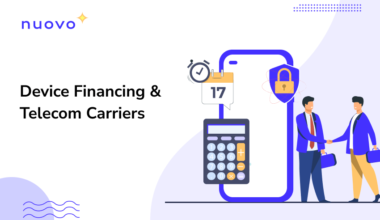5G technology is on the way to becoming the standard for mobile communications in the immediate future, starting a new generation of speed and connectivity. It is reshaping both businesses and consumers by enabling new use cases such as e-health, connected vehicles, smart stadiums, and advanced gaming.
The 5G technology has opened up different avenues in business-to-business (B2B) commerce for telecom carriers to boost their revenue potential. Consumers expect 5G-ready handsets to deliver on enhanced video, multiplayer mobile gaming, and new immersive experiences.
However, the increased costs of 5G smartphones would make upgrades prohibitive for end users. This could also prove tough for telecom carriers – unless they take an up-to-date alternative in managing 5G handsets.

What is 5G technology?
5G is the fifth generation of wireless technology. It provides higher speed, lower latency and greater capacity than 4G networks.
Why is 5G important?
5G is creating unprecedented opportunities for people and businesses. Technologies such as Augmented Reality / Virtual Reality and other technologies that make up Industry 4.0 need 5G mobile broadband to take experiences to the next level.
5G mobile subscriptions forecast to overtake 4G1
- By the end of 2027, 5G subscriptions are expected to reach 4.4 billion.
- 5G will account for 90 percent of North American mobile subscriptions by 2027.
- 5G handset sales have taken off, outpacing the 4G handset market share 10 quarters into the technology cycle.
Rising 5G smartphone costs driving the need for new solutions
According to Gartner, Inc., the global sales of smartphones declined by 12.5% in the full year 2020. The decline in sales can be attributed to high penetration levels, longer upgrade cycles of over 30 months, and a more established secondary market for used phones.
Another obstacle to smartphone sales is the fact that 5G phones will undoubtedly be even costlier to produce than 4G handsets. Estimates suggest the initial cost of 5G handsets to be 30 percent more.
With smartphone brands passing the costs down to the consumers, many end-users will be disinterested in the high prices and will push their purchase decisions to a later time in the future. Given this situation, ensuring end-user affordability will be a challenging proposition for telecom carriers.
Providing smartphone subsidies in mature wireless markets is already unsustainable, where telecom carriers subsidize their customers’ purchases of new smartphones in exchange for long-term service contracts. These high sales acquisition costs of more expensive 5G handsets are taking a bite out of earnings.
In the face of these challenges, telecom carriers need to revisit their strategies for managing their overall smartphone expenses, an often neglected part of their business. Telecom companies cannot afford to discontinue supplying handsets, because smartphones account for a major portion of a subscriber’s telecom wallet.
A potential solution to the problem is smartphone financing
To manage costs and make 5G smartphones more accessible for consumers, rather than paying upfront or receiving a subsidy, customers can finance the device over fixed monthly periods.
Smartphone financing gives telecom carriers the opportunity to eliminate subsidies. The cost of the smartphone is amortized across the length of the contract, rather than taken upfront before handing over the smartphone.
For example, the average selling price (ASP) of a 5G smartphone is 815 US dollars. Now, for a 24-month contract, the monthly payment for the device alone will be about 34 US dollars. Smartphone financing allows telecom carriers to improve their margins.

Solving the subsidy problem is paramount for most telecom carriers in mature markets and emerging markets may soon face it in the future. Device financing can help bridge the gap between telecom carriers and end-users, making it workable for companies to continue supplying 5G smartphones. But, it has to be done correctly.
Key to device financing success: Payment surety
For a telecom carrier, cash flow would be the key problem in smartphone financing. They need to pay OEMs for their phone within 30–90 days, while customer payment plans span 24 months. With the average selling price of 5G smartphones close to 1000 US dollars, this applies significant pressure on the company’s balance sheet.
The device financing model can only be beneficial when customers make their payments on time. Companies are exposed to default risk when end users are unable to make monthly payments. Device theft and SIM swapping also add unnecessary pressure on margins.
To tackle these issues, telecom carriers need built-in technology to empower customers while maximizing their business growth.
By using device financing with Nuovopay’s remote locking technology, telecom carriers can turn their smartphone business from a financial challenge into a competitive advantage.
Modern security solutions help enable telecom companies to block the devices in the event of delayed payments. These solutions follow up with customers when payments are due. This process continues until the customer makes payment on time.
Past the due date, management features are locked remotely on the phone. Nuovopay’s smartphone locking technology allows end-users to access basic functionality, such as emergency calling when devices are in a restricted mode.
Wrapping Up
The majority of consumers expect pricing innovation from telecom carriers for affordable access to 5G handsets. The smartphone financing model is a popular option to get around the cost problem, but revenue leaks are always a challenge.
Telecom carriers overcome this problem by partnering with technology companies like Nuovopay to secure their assets. Thanks to remote locking technology, companies can now leverage remote locking technology to protect their investments and cover business risks.
Get in touch to see how Nuovovpay works for telecom carriers.





